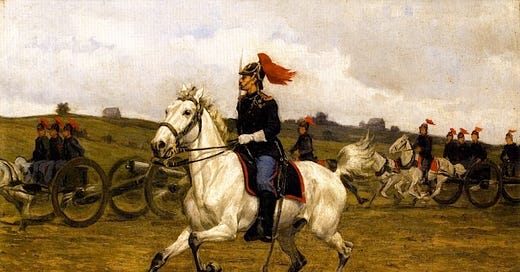From a history of The Great Artillery War of 2032:
The new distributed fires organisation made them impervious, as a collective, to what was then still called 'counter-battery' or 'depth fires'. When the Reds attacked a second time, the Reds returned to their traditional methods of deep penetrating thrusts of concentrated armour. These successfully destroyed each one-gun Battery, mostly through encirclement rather than destruction. Few detachments were brave enough to continue firing once they knew they had a thrust line on either side of them. Those guns that were still crewed by humans decided to hit the killswitch and keep their automated guns out of action, lest their lonely position was revealed.
The Blues were so overwhelmed that they were left with a literal, and a littoral, Battery. The extended range Naval guns formed miniature self-defending fire bases that continued to offer some support. Meanwhile, the literal Battery consisted of but six guns, evenly spread throughout the whole Area of Operations, and incapable of mustering any concentration of fire. The Blues had been defeated in detail.
The Blues responded by copying their Naval counterparts and found inspiration in artillery structures of yesteryear. They grouped the guns in actual Batteries, reinstated Command Posts and reinvigorated Officer appointments responsible for recce, survey, and defence. Grouped together, with some new confidence in the effectiveness of their weapons, a little emphasis on anti-tank, and the re-elevation as a Combat Arm, the Gunners had the boost they needed. These islands of self-defence now resisted the Red thrusts.
The Reds then found that their penetrating manouevres had burnt out and they took to this emerging character of attritional exchange. They responded to the crisis by dusting off their rockets and set about relearning the art of the stonk.
The Blues islands preceded to move in response and the tit-for-tat became routine. Patrols and a vague allusion to initiative became important. As did banked earth and dark underground hiding places.
Before long, both the Reds and the Blues rediscovered infiltration. They noticed it in each other and started copying and spiraling into the practice until it became the normal form of combat. These patrols started to become smaller. They had a guerilla-like form, but with the pervasive presence of combined arms in miniature. Every patrol owned a barrel, a gun, a flamethrower, or a drone with a gadget attached. Each had a unique tool to crack whatever nut it found. The purpose of command became resourcing wherever success was hinted at.
The battlefield was now awash with independent action. It was anarchy. The only form of order were these little Blue islands of guns floating to and fro, concentrating their fire wherever command willed.
The Reds then returned to their thrust lines and found the jelly-like forward line easily pushed away.
The Blues hardened. They re-concentrated their battalions, forming defensive depth that stood up to most batterings. But then the Red stonks started to find them, so the Blues took to movement again and struck upon the idea of treating each gun as its own fire unit…






Valentinus- I like the philosophy of this piece, especially on waiting. Hope you're well this week. Cheers, -Thalia
I’m waiting on the couch
Woobie in hand